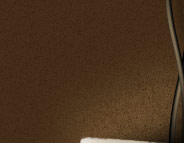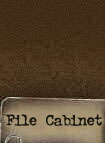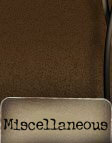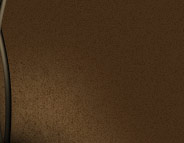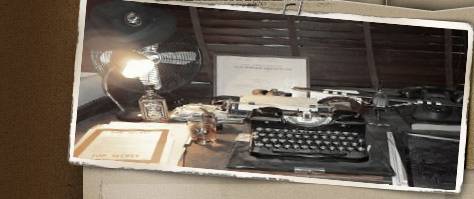|
REASON FOR INVESTIGATION:
While researching documents and
analyzing of photographs of
Operation Market Garden, it came to
this agency's attention that three
specific photographs are featured in
almost every publication. Each of
these images is action packed and
captures many of the circumstances,
so characteristic of the campaign.
These images are also staged,
simulated, reenacted for the camera.
Operation Market Garden was thought
of as the last big battle before
Allied forces could drive into
Germany and force the Nazis into
defeat. Moreover, planners were
confident that the operation would
be a success. It was therefore
considered wise to have photo and
film cameramen as well as reporters
of all kinds of military and
civilian news media, embedded in the
various units that made up First
Allied Airborne Army in the invasion
of The Netherlands. Market Garden
therefore was an operation that was
extremely well covered by the press.
This Battle Study describes the
origins of the three best known
Market Garden photographs.
SYNOPSIS:
Photo # 1:
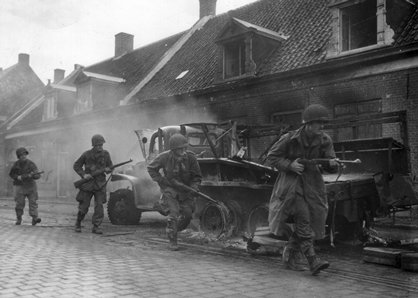
"US paratroopers
fight in Veghel to keep Hell's
Highway open."
Description:
This photograph is evidently
intended to depict the struggle of
the American airborne troops to keep
the Corridor, which they dubbed
'Hell's Highway', open.
The photograph shows four soldiers
of the 326th Airborne Engineer
Battalion moving forward on Hoog
Straat in Veghel. They pass a
burned-out American GMC truck of
quartermasters of the 101st Airborne
Division. This truck had brought
gasoline in jerry cans and had come
to Veghel in the division's
so-called 'seaborne tail'; meaning
not transported by air but driving
from the Belgian border up the
corridor. The truck was hit by a
German Jagdpanther attacking Veghel
in an attempt to cut the corridor .
Date: September 23rd 1944
Location: The Netherlands,
Veghel, Hoog Straat,
Cameraman: Unknown cameraman,
the credits for this photograph are
always for the US Army Signal Corps.
Details about staging: These
airborne engineers appear to move
forward cautiously but the cameraman
is in front of them with his back to
the 'enemy'. Also, the fighting on
the 23rd of September in the Veghel
area took place on the countryside,
South of the town.
Details about location: This
location is also featured on our
Now&Then Holland (1)-page:
(click on the image
for a full size comparison)

Photo # 2:
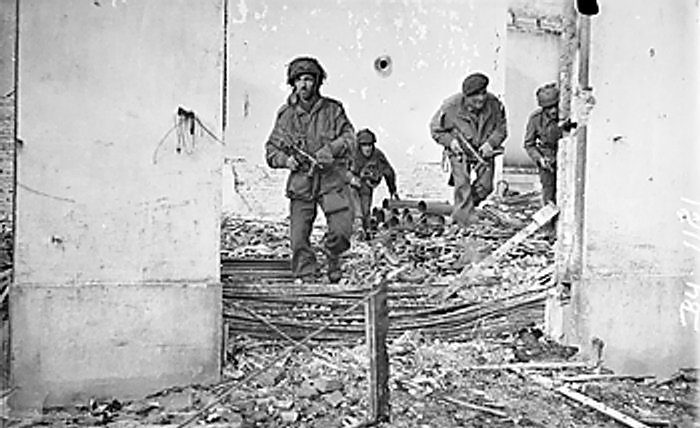
"British glider
pilots fighting in the perimeter
around the Hartenstein hotel in
Oosterbeek."
Description:
This photograph appears in almost
every book about the Battle of
Arnhem. Captions under this photo
all refer to the heroic battle of
every soldier in the British 1st
Airborne Division, even of the ones
bringing them to the battlefield.
Although their uniforms do not give
clues to their specific units, these
men are almost always identified as
glider pilots. British army
regulations prescribed that glider
pilots, after landing their
aircraft, would serve as infantry
soldiers. Because all glider pilots
carried the rank of Sergeant, units
made up of glider pilots were
referred to as the 'Army of
Sergeants'.
Date: September 1944 23rd
1944
Location: The Netherlands,
Oosterbeek, Utrechtse Weg
Cameraman: Sergeant Mike
Lewis of the Army Film and
Photographic Unit (AFPU). Lewis was
part of a group of photographers,
movie cameramen and news reporters
who were embedded in the 1st British
Airborne Division.
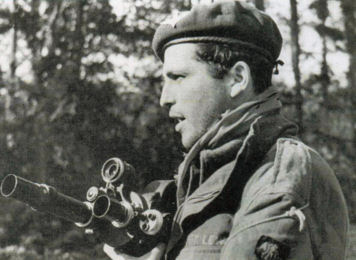
Sgt. Lewis
When this division's mission to
capture the bridge at Arnhem failed,
all elements of the division west of
Arnhem fought a defensive battle
against numerically superior German
forces. Center of the defensive
perimeter was General Urquhart's
headquarters in the Hartenstein
hotel. In a later stage of the
battle, the AFPU-members moved from
their initial location on the
western edge of the perimeter to
this HQ.
Details about staging: It has
never been much of a debate that the
troopers in the photograph posed for
the camera. Again, the cameraman is
with his back toward the enemy. One
soldier even looks into the camera.
Veteran Harry Faulkner-Brown in
his 2006 book "A sapper at Arnhem",
Published by R.N. Sigmond (ISBN-10
9080471895, ISBN-13
978-9080471894), is very clear about
the staged photo as on pages 65 & 66
we read:
"Our position
[was] in one of some ruined
one-storey buildings which had lost
their roofs and some of the external
walls facing us. They probably had
been stables or garages for the
Hartenstein Hotel. About the middle
of the morning, a group of about
four members of the Division
appeared with a press photographer,
who proceeded to take shots of the
group moving through the ruined
garages. After everything we had
been through we were rather
disgusted at this untrue, artificial
display of house clearance and my
sappers gave them a few boos and cat
calls as an indication of their
disapproval."
Details about location: It
has long been a mystery where this
photograph, frame 7 on the 4th roll
of film that Lewis shot during
Operation Market Garden, was taken.
Many accounts describe the
construction material apparently
stored in the building. It was
sometimes suggested that somebody
had been hiding the hardware during
the German occupation, intended for
postwar use. Few people, however,
noticed the black-ringed entrance
hole in the back wall of what
appears to be an armor piercing
shell. Also of interest is the upper
part of a hand-cranked water pump,
visible at knee-height of the
soldier second from the right. This
item is supporting evidence of the
discovery made by Dutch
historian Robert Voskuil, of the
Friends of The Airborne Museum.
A thorough investigation made by Mr.
Voskuil revealed that the
destroyed house is in fact a winter
garden that stood East of the stable
block of the Hartenstein hotel. The
building was used to let potted
plants 'hibernate' inside it during
the winter. Unfortunately there are
no good photographs of the building
as it was. After the war it was
demolished and never rebuilt. Aerial
photographs, taken in 1945, show the
roofless building. From an
enlargement, the L-shaped wall in
the back of the 'combat-' picture
can be seen.
Voskuil's findings were published in
the December 2004 issue of the
Museum's Newsletter.
(click here for a translation of the
article)
.jpg)
Stables and winter
garden of Hartenstein Hotel, 1945
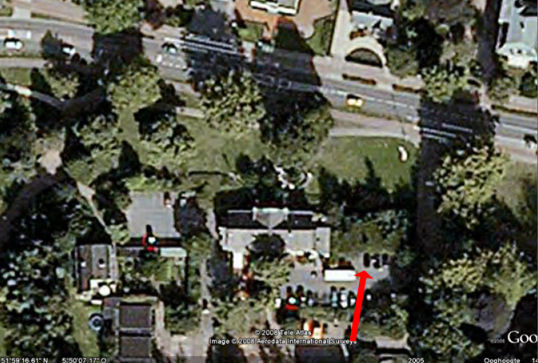
Restaurant Kleyn
Hartensteyn, today
Battldetective.com went to this
location and found the plot where
once the winter garden was:
(click on the images
for the full size photographs)
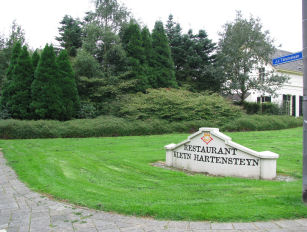
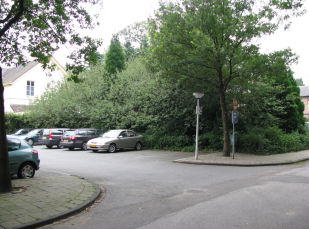
We took this comparison photograph
from the same spot where Lewis
stood:
(click on the image
for a full size comparison)

Possible legible symbols on
wall in picture
While studying a large print of the
complete image on the film frame
battle detectives noticed a number
of white dots, visible in the upper
right corner of the photograph. At a
first look, these dots look like
letters and figures forming a text
of some sort. Detectives Tom and Ivo
were under the impression of seeing
a text resembling 'telefoon' and 'weg'
(Telephone, Road) and the numbers
"64" or "54".
Careful examination of the print
with a normal magnifying lens gave
an enlargement of the 'symbols' but
did not reveal a legible text.
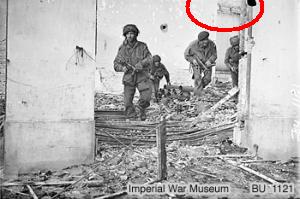

Since the British Imperial War
Museum is to be credited for Lewis'
photograph, we have requested a
photograph from the negative there,
as only a direct print could enhance
the resolution of the picture and
the white dots we have discovered.
The high resolution scan came from
the Imperial War Museum into our
office on the 26th of August, 2008.
Unfortunately their version revealed
no further clue:
.jpg)
We will bear this text hypothesis in
mind until we find a technique to
enhance the alleged symbols.
Photo # 3:
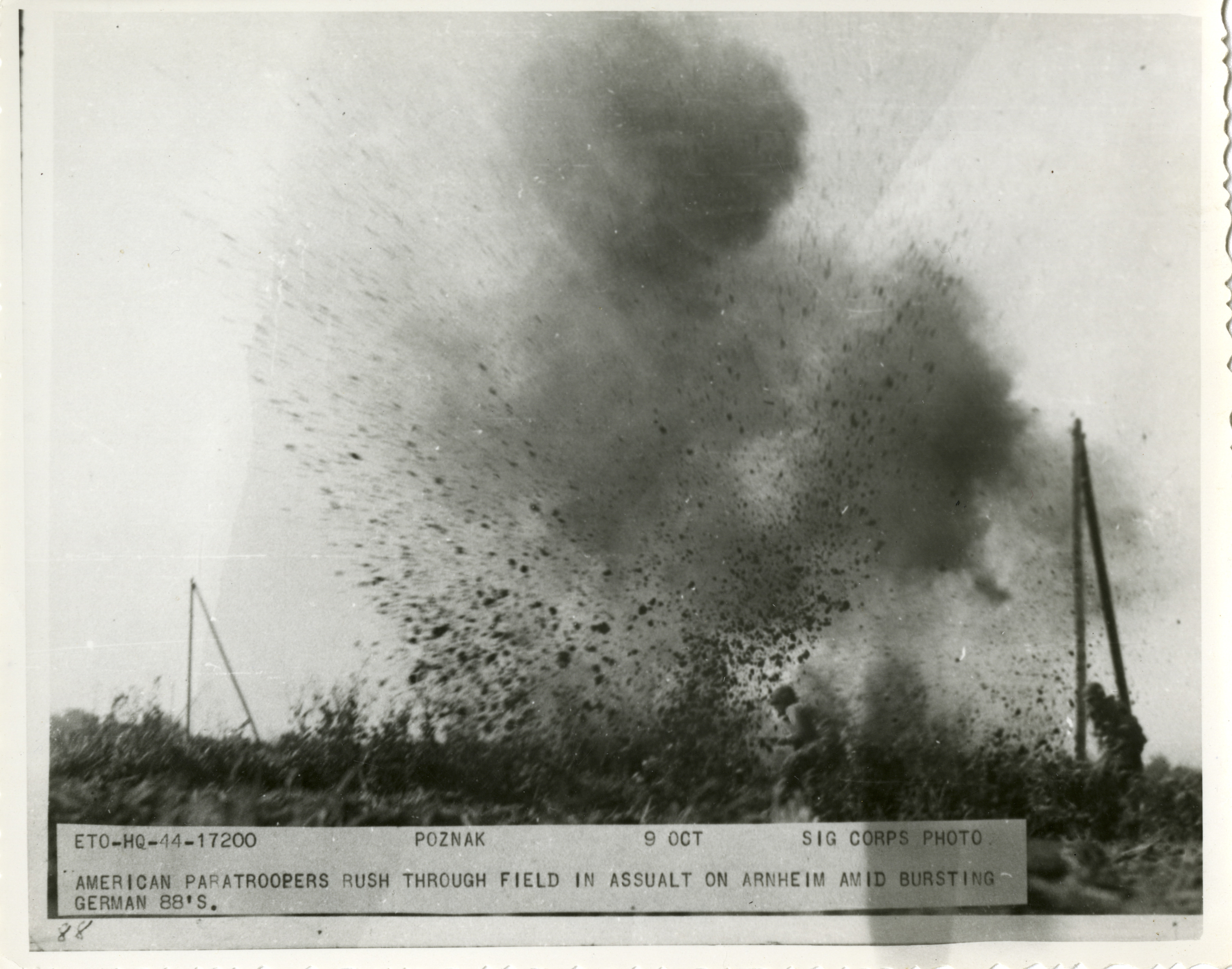
U.S. Army Signal
Corps photo ETO-HQ-44-17200
"American
paratroopers rush through field in
assault on Arnheim amid bursting
German 88's"
Description: United States
Army Signal Corps photo
ETO-HQ-44-17200 showing two American soldiers
cross a field while one of them
stands approximately three feet away
from an explosion that kicks up a
fountain of dirt. This US Army
Signal Photograph is often used to
illustrate combat by US paratroopers
in The Netherlands in general.
Hardly ever is any reference made to
a specific unit, location or date.
Sometimes captions under this
photograph mention that the
explosion is caused by a German 88
millimeter gun.
Date: 9OCT1944
Location: Betuwe Region, The
Netherlands
Cameraman: Private Murray P.
Poznak, US Army Signal Corps.
Details about staging: On
page 205 of Mark Bando's Vanguard of
the Crusade we read:
"Life at Dodewaard
Southeast of Opheusden, elements
of the 502nd held the southwest
flank of the division line near
Dodewaard. Action in the area was
mostly limited to patrolling, and
many men were killed or wounded by
the thousands of German land mines
planted in the area.
A press photographer visited this
sector during October and told
Schuyler Jackson that he wanted to
get a great action photo. At a loss
for what to do, the men decided to
"stage" a picture. They planted some
C-2 explosive rigged with a remote
detonator in a nice pile of mud and
positioned one trooper to the rear
of it. The trooper struck a pose
with his weapon at the ready and at
a given signal, the charge was
detonated. The photographer snapped
a still photo of the explosion and
the photo was later published in
many books, newspapers, and
magazines. The caption said the
pictures showed an American
paratrooper near Arnhem, advancing
under 88mm fire. It was hailed as
one of the great action shots of
WWII."
Common practice to use army
resources for media photographs
On page 408 of George Koskimaki's
book 'Hell's Highway' we read that
during the 502nd Regiment's
deployment in the Dodewaard area it
was not uncommon at all to make use
of army property and personnel in
order to help news media to get war
photographs:
"During the same afternoon
[October 16th, 1944], a team of
photographers and writers from Life
Magazine appeared on the scene. They
wanted to photograph the capturing
of prisoners.
The diary of S/Sgt. Earl Cox of "F"
Company had this notation for the
16th of October: At 1435, a combat
patrol sent out to houses at our
immediate front supported by tanks
and artillery. Captured two
prisoners. Mission successful.
Artillery from enemy had direct on
CP. No casualties. Moved CP next
door. Patrol action was
photographed.
"I remember an incident that took
place up on the Island," wrote Sgt.
Howard Matthews. Lt. Col. Allen
Ginder came up to the front lines of
'F' Company with three reporters
from Life Magazine. They wanted
pictures of Germans being taken
prisoner. A squad from 3rd Platoon
went out with them across a field
and into a woods in the German
lines.
'When they left, we took a machine
gun and moved to the left of a field
and down a drainage ditch of the
field the 3rd Platoon squad crossed.
We spotted a German squad moving
down the ditch trying to cut off the
3rd Platoon squad. We opened fire on
them killing several and two of them
raised their hands and surrendered
and came down the ditch to us.
Meanwhile, the German troops in the
woods opened fire on Ginder and the
squad. Ginder was wounded in the hip
and leg. He was carried back with
other men from the squad. The Life
Magazine people were unhappy because
they were not used to being shot at.
LTC Ginder was unhappy because he
got shot. But then the Life Magazine
people were happy when I gave them
two Germans to take back with them."
Details about location: The
location of the staged photograph in
Mark Bando's account is near
Dodewaard. The 502nd was in fact in
Dodewaard toward the end of the
Division's deployment on the Island.
Historian Peter Hendrikx, however,
remembers this:
"Near the end of the 1980's, I
was on The Island together with Sky
Jackson, Colonel Robert Jones and
also with Joe Ludwig if I recall
correctly. On that occasion Sky
[...] said that the specific
photograph was taken in front of the
former post and telegraph office. In
that building were their
headquarters and as a member of
"HQ"- Company it is likely that he
was around when the British
correspondent asked them for an
action photograph. This old post
office building was still there
during the end of the 1980's, but in
the meantime the whole surrounding
area had been built up. A comparison
photograph is therefore difficult to
make. I think I recall that it was
in the center of the town of Elst,
in the main shopping street.
[...] By the way, after
publication of the photograph, the
English press immediately expressed
its doubts with respect to the
authenticity of this action
photograph. Sky had a newspaper
clipping with the caption: "Is this
photo too good to be true?" I do not
remember what paper and what date it
was, probably October or November
1944."
.jpg)
Schuyler "Sky"
Jackson
Research in Spaarnestad Photographic
Archive in Haarlem, The Netherlands
Since the photograph is apparently
taken in The Netherlands, battle
detectives Ivo and Tom visited the
Spaarnestad Photographic Archive in
Haarlem on the 20th of August
2008. The Spaarnestad archive keeps
millions of photographs on file and
is the largest in The Netherlands.
Remarkably, prints of this
photograph are filed in two separate
folders; "Arnhem" and "Normandy".
Also, they are of different
dimensions and show slightly
different images. We assume that one
of the prints shows the complete
exposed film frame.
Also of interest are the stamps,
captions, and notes on the back of
the photographs.
Photograph from "Normandy"
folder:
On the back of this print a caption,
typed on a slip of paper, was glued,
reading:
(click on the image
to enlarge)
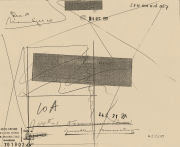
"THE YANKS IN THE ETO"
82. "And the krauts threw everything
in the book
at us, including the mud from under
our feet. "This
show didn't come off too well at
all, at all."
U.S. Signal Corps Photo EA 42236
CERTIFIED AS PASSED BY U.S. FIELD
CENSOR"
Similar slips with captions,
apparently from the same series of
"The Yanks in the ETO" were found in
other folders with World War Two
photographs in the Spaarnestad
archive. This print seems to display
the complete image on the exposed
film frame.
Photograph from "Arnhem" folder:
The familiar transparent Signal
Corps seal is printed on this
photograph. On the back of the print
are an official Signal Corps stamp
and a caption, printed in purple
ink, reading:
(click on the image
to enlarge)
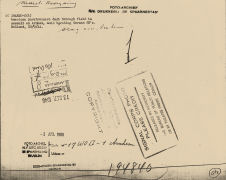
"SC 194840-S(A)
American paratroopers dash through
field in
assault on Arnhem, amid bursting
German 88's.
Holland, 10/9/44."
This print seems to display a
slightly cropped version of the
image on the exposed film frame.
Remarkably, these photographs have
three different Signal Corps photo
numbers; ETO-HQ-44-17200, EA 42236 and SC
194840-S(A).
The photographer, Murray P. Poznak
is known to have taken several
photos in the Nijmegen area during
Operation "Market Garden".
This is Poznak posing with two Dutch
children in that area:
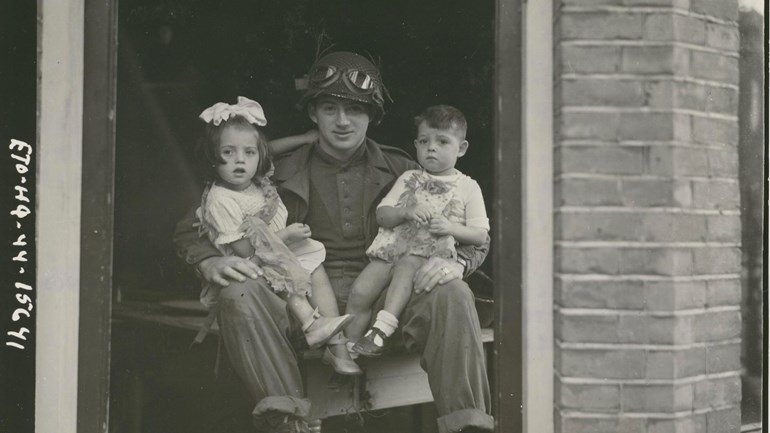
U.S. Army Signal
Corps photo ETO-HQ-44-15641
The photographs in the archive do
not reveal clues as to the exact
location. Because of the mentioned
date, October 9th 1944, and the
visible helmet stencils and shoulder
patches in the photographs, it can
be concluded that the depicted
soldiers are members of the 101st
and that the photograph was
therefore taken in the general area
known as 'The Island'. The towns of
Dodewaard and Elst are located in
that area.
Elst as possible location of the
photograph
+ The only clue in support of
this location is Peter Hendrikx's
account.
- Speaking against this town
as the location, is the fact that
the 502nd was not stationed in Elst.
- And although there is
photographic evidence that there
were telephone poles in the street
of the town hall and the post office
and this same evidence shows that
these buildings were in the center
of town, surrounded by other
buildings, not muddy pastures.

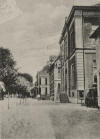
(click on the images
to enlarge)
Today, like Peter Hendrikx stated,
the old post office building has
been demolished to create space for
the town hall's modern annex. The
building next to the old post office
was the Roman Catholic Society's
building named 'Het Centrum' (The
Center). During the German
occupation it was requisitioned by
the Germans and used as 'Ortskommandatur'
(Town Commandant's Headquarters).
Today it houses a dispensary
drugstore named 'De Batauwe' (old
spelling for the Betuwe Region).
This is a photograph that we took
recently, showing the gap between
the town hall and the next building, were
the post office used to be:
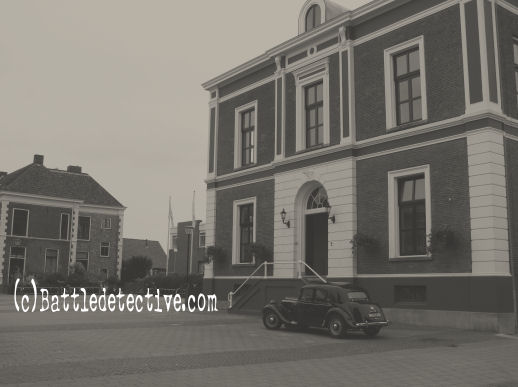
Standing in front of the town hall
and the plot were the post office
used to be (like in Peter Hendikx's
recollection of what Sky Jackson
said), this is what the Signal Corps
cameraman would see today:
(click on the images
to enlarge)


view from town hall
view from post office site
Two features in today's view from
the post office plot, lead us to
believe that our action photograph
was not taken in across the street
from this building:
Location of recent SS atrocities
to inhabitants of Elst
In a straight line from the building
(behind the (c) symbol in the above
'Today photograph') is
a monument to three civilians from
Elst, who were murdered by SS
troops on the 14th of September
1944. These men, two school teachers
and a civil servant where killed
just three days before the start of
Operation Market Garden. The reason
remains a mystery today, but it is
believed that the Germans wanted to
punish the people of Elst for the
destruction of a military vehicles
by randomly picking some towns
people. The monument was erected
shortly after the end of the war,
but it is likely that a makeshift
marker was made already when the
101st was deployed on 'The Island'.
The marker might either have showed
in the action photograph. Also, the
story has it that the three victims
were lined up against a wall and
where shot. There is no wall in the
action Photo. And finally, a marker,
or knowledge of what happened on
this spot would prevent demolition
men to use this area as a backdrop
for the photo.
Building in modern Elst was there
in 1944
Judging from the architecture of the
building across the street, it must
have been there in 1944.Today,diners
are welcomed in it, as it houses the
'Hartelust'
('Heart's Content) pancake
restaurant. Battledetective.com
conducted an enquiry by telephone
and talked to restaurant staff and
management. One of the waitresses
went outside for us and read the
text on an engraved gable marker out
loud. It reads (translated from
Dutch):
"Monument Stone to
Josje Jaspers
July 1939"
The manager explained us that the
building dates back from the 1930's
and that until 1999 it was used as
the practice of a local medical
doctors family named Jaspers. It
became a pancake restaurant in 2000.
As this building would become the
backdrop for a photograph taken
across the street, we consider it
even less likely that 'our'
photograph was taken inside the
built-up area of Elst.
Dodewaard as possible location of
the photograph
Positive indications that the
photograph was taken in Dodewaard
are:
+ the 502nd was stationed in
and near that town.
+ a comparable incident with
photographers being assisted in the
creation of a spectacular picture
occurred in Dodewaard.
There still are leads to be
developed such as researching the
building were the demolition team of
the 502nd's "HQ"-Co. was quartered
and what the immediate (rural)
surroundings of it looked like at
the time. In the mean time, given
the pro's and con's, we have the
working hypothesis that this
photograph was taken in or near
Dodewaard.
Battledetective.com visited
Dodewaard and found the building
that used to be the town hall:
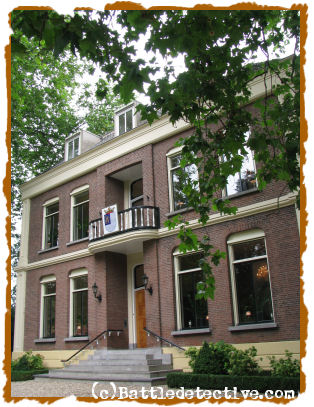
Until today, we are not certain if
this was the Regimental Headquarters
of the 502nd, nor if "HQ"-Company
Demolition team was billeted here.
This building is within the built-up
area of Dodewaard surrounded by
buildings from an time before 1944.
For our comparison we therefore went
to "The Island" area, picked a
random pasture along the road from
Elst to Dodewaard and took this
photograph:
(click on the image
for a full size comparison)

Our educated guess and random choice
turned out not to be that
far-fetched!
Shortly after our visit to The
Island and taking the photograph of
the 'random pasture', we discovered
this photograph, taken shortly after
all the fighting on The Island had
ended:
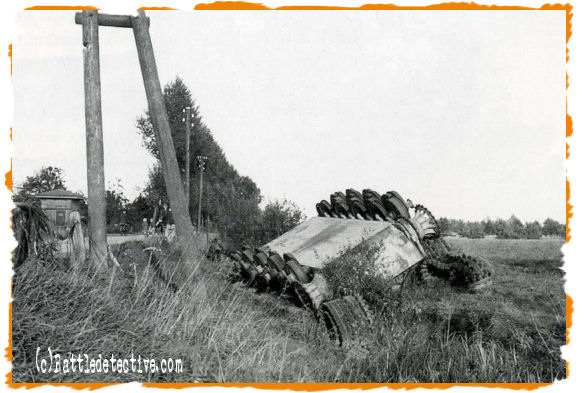
It shows a knocked out German tank,
'turned turtle' on the exact same
stretch of road as where we took our
photograph!
This is an impression of this same
T-intersection of Valburgse Weg and
the road to the hamlet named Homoet,
today:
(click on the images
to enlarge)




Note that the same electrical power
relay station is still there, be it
with a new flat roof. The period
picture shows the same 'Letter A-
telephone wire poles' as in the right
hand corner of the Signal Corps
'action photograph' discussed here!
Another possible clue
The complete exposure of the
negative shows an object in its left
corner, which in most publications
is cut from the print.

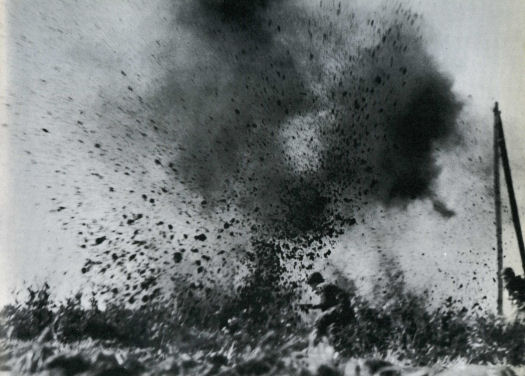
'extra exposed
section that is usually published
section'
It appears to be a set of two long
objects, like poles, but in our
opinion, they are slimmer than
telephone wire poles:
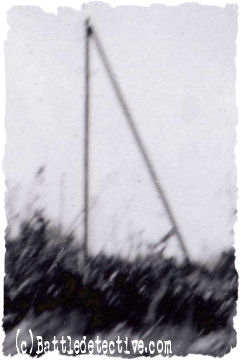
Also, for a 'Letter-A'
configuration, the pole on the right
is spaced too far from the vertical
pole and the cross-bar would be
missing. This new feature may be of
help in our still active research to
the photo location.
CONCLUSIONS:
|
